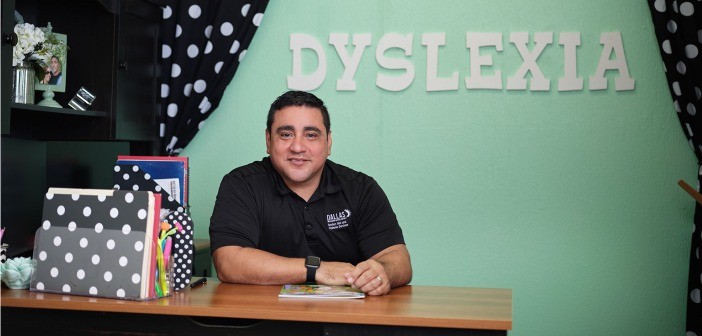As an 8-year-old, John Paul Gonzalez often felt dumb and he would pray for help to be able to read. He used to place a book under his pillow to give God a hint that he needed help to make sense of the letters in the book.
His prayers were answered the next year when his new third-grade teacher told his mother that she thought he might be dyslexic. After being evaluated and receiving additional support, Gonzalez figured out the code and was able to read.
“If I had not received the services, I could almost guarantee you I would have dropped out of school,” he said. “It’s that life-changing.”
Today, as a dyslexia evaluator and licensed therapist Gonzalez helps Dallas ISD students figure out the code so they, too, can read at grade level and succeed in school. With 147 therapists and 27 screeners, Dallas ISD has one of the largest dyslexia programs in the country, and this has had a positive impact on students who on average get diagnosed two years earlier than they did three years ago. Dallas ISD provides dyslexia services to more than 3,600 students, and National Dyslexia Awareness Month, celebrated in October, highlights the difference programs like these makes in their lives.
Studies indicate that as much as 15 to 20 percent of the population could be dyslexic but go undiagnosed.
“Sometimes, we’ll have kids of average to above-average intelligence with really high IQs that learn to cope until they reach the tipping point at a later age,” said Gonzalez, who became a licensed therapist in 2006. “They memorize, use cognitive skills to achieve, but as the academic rigor reaches a point where that no longer works.”
The earlier the diagnoses take place, the sooner students can receive the help they need to succeed, whether it’s therapy and 504 accommodations so they can thrive in a general education classroom or receive other special education services to help them make significant strides in their education.
“We know that research says that early identification and early remediation are key,” Gonzalez said. “At a young age, I was able to overcome. When we are faced with problems in something as important as reading and you learn to overcome them, it makes all the difference in the world. I still have a difficult time distinguishing between i and e sounds. Even today, as an adult, I have to use the code, to hear the initial sound and the keyword.”
Parents often see their children struggle at home, but don’t always identify the struggles as dyslexia. That is why teachers receive special training to more easily identify signs of dyslexia and make a referral.
After the referral, students undergo a cognitive test to determine their dominant language. Once they screened has the information, they use the data and numbers to determine what level of support is needed. Remediation is done in Spanish or English, depending on the child’s dominant language. If the student speaks Spanish, the therapy takes place in that language and then is transferred to English. The Esperanza Program teaches and remediates language acquisition in Spanish, and then students transition into the Wilson Reading Program where students learn the English morphology and study the language. Dallas ISD uses an instructional program using visual, auditory, kinesthetic, tactile modalities that help students that helps students decode the language.
It took Gonzalez about a year to be able to change the way his brain processed language. Being able to share his experience and his own struggles with parents and teachers is important for Gonzalez. It shows them that there’s a success story behind every struggle.
“The first thing that changed for me was my confidence,’” Gonzalez said. “My inside was able to shine because now I knew I wasn’t dumb. I just needed a different way to break the code—reading is a code. There was a pathway that was lit, that I could see and follow. I am a licensed therapist because I was a kid at 8 years old when I got the dyslexia services that changed my life.”

